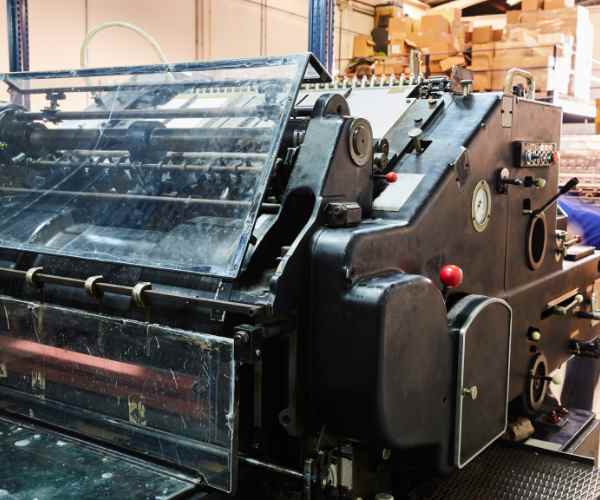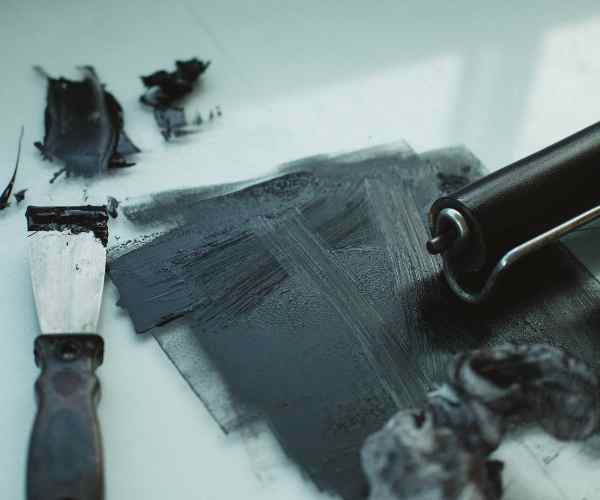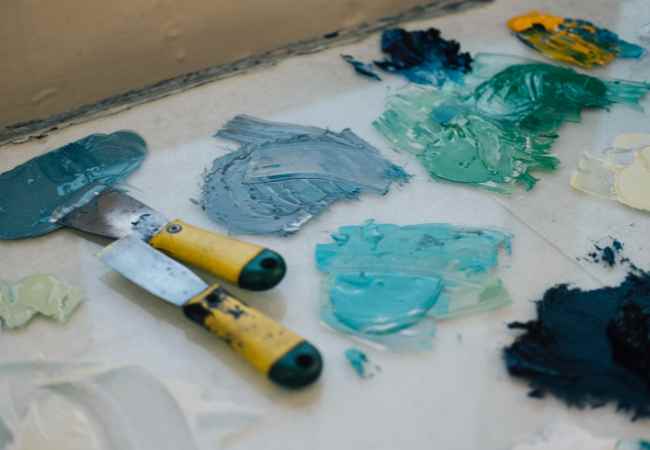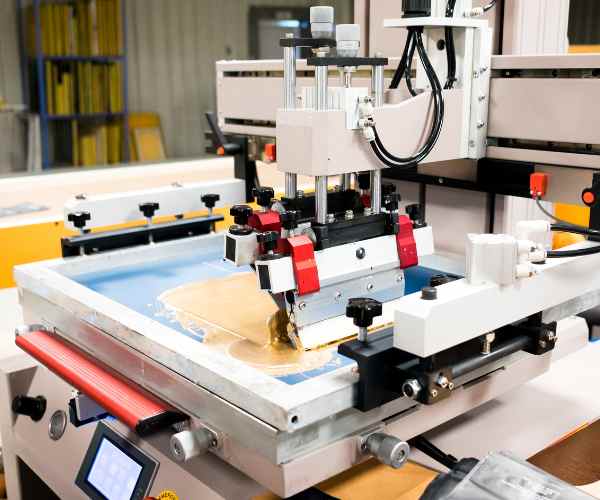A look into the history of lithography in printmaking isn’t just a history of progress with art rather there were extensive advancements in technology as well.
Think of a time when an artist had only woodblock printing or metal plate engraving, it was troublesome to say the least.
Now, there existed a new technique that without a doubt revolutionized the entire world, which was lithography, dating back to the late 18th century.
The journey of lithography first started back in 1796, when a younger German actor and playwright by the name of Alois Senefelder had been trying to print off his scripts and came up with something completely new.
With senefelder inventing lithography the world of printmaking changed forever.
Now traditional techniques that required a lot of time, skills and resources, were no longer the only ways to create art.
More spontaneity was practiced, allowing the artist to draw directly onto a piece of surface which would become a printing plate.
Accessibility made this technique extremely popular throughout the art community as because printmaking was now democratic.
There was no longer any extensive training that an artist needed in order to create top tier prints, which allowed a wider range of people from diverse backgrounds to recreate.
Indeed, lithography completely flipped the world upside down as it made room for new ideas and voices to thrive in the new and ever expanding art universe.
 History of Lithography in Printmaking
History of Lithography in Printmaking
The Birth of Lithography
The 17th century lithography, firstly invented by Alois Senefelder, is attributed as the most radical alteration in the world. Imagine this: Senefelder, annoyed by the constraints associated with conventional prints, commenced making use of flat stones and greasy ink. It was surprising that he was able to scribble on the flat stone using a grease pencil and apply an ink that was designed for print and go only with the greasy spots on the stone. He tried a couple of things and came to the conclusion that he could print out the stone on paper which resulted in an image that resembled closely to the drawing. Imagine the delight he was feeling watching his very first lithograph fully formed! It was a moment that rewrote not only his life story but the entire story of printing.
The technique that he developed started with an understanding of the fact that oil and water repel each other, a fact that was the basis of all the lithography processes that we enjoy today. Artists began developing an interest in this new process as it enabled them to practice their art in a previously unthought-of way. Lithography was no longer the monopoly of the few. It turned into a means of the people rather than of elites. Early Applications in Art During the early days of lithography’s introduction to the world, artists widely used the artwork in their practices.
The potential of lithography was recognized by a number of artists even in its early stages as it lent itself to several kinds of experimentation. Jean-François de Troy was one of the first artists of note who utilized this technique and was born in France as both a painter and printmaker. His works demonstrated the versatility of lithography, showcasing detailed landscapes and lively scenes that resonated with the public. By using lithography, artists were able to make several copies of an image which further increased the ease of mass marketing their art. The increase in demand for lithographs led to lithographs that became exceptionally famous and would influence the evolution of engravings in future societies.
The German artist Eugène Delacroix created several lithographic images that were produced so that the vibrancy of colors, alongside the strong and romantic strokes on the lines were captured. These prints vibrated his paintings in a very pulsating manner. Aside from making multi copies of art, lithography helped bring artists and art lovers together in the same community. Even after the use of lithographs was gone, they aided communication and gave birth to new ideas and artwork of famous artists. The Evolution of Lithography Techniques From Stone to Plate. As we explore lithography further, some of the more fascinating pages of its history are its early shifts, such as the transition from lithographic stone to metal plates.
Imagine the early lithographers huddled around rigid flat stone slabs and tracing their designs using grease pencils.
This approach indeed was quite revolutionary but not without its drawbacks like the hefty and encumbersome nature of flat stones.
What do you suspect would be the case of one’s back after carrying the relatively larger stone slabs?
Then, during 19th century, the introduction of metal plates came in as a great breakthrough.
These not only became a more lightweight than stones but enabled better and accurate representation of images.
Trace engraving pencils that utilized aluminum and zinc had began to come into use will presented much more detail and had better resistance.
The availability and compatibility of printmaking using metal plates surely had better step up.
The ability to create finer details in visual representation surely meant that the prints were more eye catching than previously.
Additionally, the thin film simplicity allowed for easier carrying and usability of lithography for many other artists, eliminating the barriers preventing open creativity with lithography previously.
I still remember an exhibition that had prints done through a side by side comparison display where one side was done through stone and plates on the other.
To my surprise, the output using metal plates alone was largely different by virtue of metal being more flashy than stone and allowing for more detail and clear representation.
Lithography Changes the Game
The advancements in lithography technology did not end with metal plates, they evolved into various interesting methods. These include the likes of color lithography and offset lithography.
Among lithographic printing techniques, color lithography was able to broaden the horizons of artists.
Just by visualizing a thought of painting different colors on plates or stones to combine them into a single picture can be jaw dropping.
One artist who used it extensively is Henri Toulouse-Lautrec.
Having designed colorful posters for the Moulin Rouge, Toulouse-Lautrec was able to represent Parisian nightlife and movement and emotion utilizing color lithography was almost unheard of before.
Later developed offset printing technology took lithography further.
Instead of making printed copies directly as in litho, this method uses metal plates, which are then transferred to rubber blankets and afterward to paper.
That catapulted not just printmaking to a new dimension but made great changes in the publishing industry as well.
I remember reading that large-scale publishing houses started using lithography in a bid to produce multi colored magazines quickly and cheaply.
Offset now formed part of pop art with Warhol questioning the very nature of consumerism while joining the bandwagon of mass productions.
With these inventions, lithography made the transition from a traditional craft to a new way of creating and this new invention benefited both artists and the audience to a great extent.
Lithography’s Place in Art and Society
Commercial Uses of Lithography
Undoubtedly, lithographic arts transformed the world of fine arts, advertising, political campaigns, and social movements as well.
Consider how much impact can be carried in a single, powerful toy poster.
In the 19 century, lithographic techniques made possible the production of colorful, wall and street poster which could be distributed almost anywhere, far and wide.
Let us take into account the “I want you” example, Uncle Sam urged the youth to participate in the World War 1 sexual Offence campaign.
This lithograph masterpiece created by James Montgomery Flagg is a testimony of American patriotism, and that spirit still finds echoes.
And when a poster can contain the feeling and essence of the time period and crises of the world, it’s pretty incredible, isn’t it?
Lithography was also important in the suffragette movement: there were pictures that strongly supported women’s suffrage.
Images of powerful women became tools for change, and the media were reminded that images could be used as effective tools for social change.
The Relation Between Lithography And Other Art Forms:
- It is unquestionable that lithography has left a mark and prevailed through other art forms and has greatly influenced them to transform as well by claiming its unrivaled nature.
- When the artists took on lithography the artists began using it on its own to elevate their work to a whole other level.
- For instance, in his works, Picasso used lithography to take his art to the next level, exploring new tools.
- Lithography, in particular, allowed him to actively engage with his audience in a completely new way, creating powerful pieces with strong strokes alongside intricate forms.
- Graphic product design is yet another area where lithography has made a difference.
- Jets from lithographic printing enabled the designer to be able to print even more even more stunning billboards and book covers that would capture anyone’s attention.
- I once visited a gallery dedicated to book design and there were lithographic printed covers that instantly caught my eye and nearly pulled me in to read the book.
Artists have been able to evolve lithography into a whole new genre that allows them to communicate and intrigue their audiences through the art they create regardless of what the medium is.
Current Trends of Lithography:
A hybrid between the past techniques and current trends seems to be efficiently embodied by modern day lithography.
First of all, it was believed that alongside the development of different digital means, the traditional ways of manual printmaking would be erased, but this could not be further from the reality!
In fact, artists of today are not only keeping the essence of lithography in existence, but are also embracing it in modern techniques and approaches.
One such example is Julie Mehretu, who has created some stunning pieces by combining multiple layers of imagery and texts that visually talk and make sense.
Her pieces are often globalisation and urbanisation themed which makes lithography targeting a modern audience possible.
Moreover, lithography also found shelter in workshops and artist residencies, through which new age artists have been ensuring to keep parts of tradition and their own selves into what they create.
I recently visited a printmaking workshop which was attended by artists of every age, along with modern interpretations of classic pieces using lithographic stones.
The atmosphere was energetic sparkled with every artist exchanging tips and techniques making the lines of past and present rather vague.
This spirit of collaboration emphasises on the importance in keeping the practice of lithography alive, as it is a continually practiced and evolving form of art.
The Evolution of Lithography
Now, let’s look to the future and try to predict how lithography will fit into the digital world.
With the pace at which technology is evolving, it is interesting to think about how these changes may affect the world of printmaking.
As I said above, digital lithography is already in progress taking traditional techniques integrated with new age technology.
Artists are employing software to compile pages that can easily be transformed into lithographic prints meaning that the two can blend without hassle.
Let’s speck about the endless possibilities!
It means that artist can now print and reproduce easily and makes it available on the Internet which makes it easier for them to distribute it out to a larger audience.
But while technology is going to have an effect on lithography for sure, I think there are qualities to traditional print making that are simply in its physicality that will continue to endure centuries of technological change.
The actual act of hand-drawing on a lithographic stone or prepping a metal plate might have a certain romance to it that a digital program can never quite achieve.
In my opinion, this attitude is however not realistic as there is an ever bright limitless future for lithography in this coming new era that lies ahead of us.
A more interactive way of utilizing hybrid techniques through cross disciplinary ways can enable the art world to become even more vibrant and diverse.
A year ago, I went to a gallery with both emerging and established artists, featuring hybrid works of traditional lithography and digital printing.
The pieces made a very impressive statement of how lithography’s essence could survive ideally for the coexistence with emerging technologies.
Frequently Asked Questions
What is lithography, and how does it work?
Lithography is a printmaking method that is based on the premise that oil and water do not mix.
An artist begins by drawing a picture on a flat surface which could either be welled in stone or built on a slab of metal.
A coating is then applied on the surface of the items, which in essence attracts any ink-covered material and in a way repels any raw ink.
Once the coating is dry, the plate is oiled and then pressed down on a piece of paper and a print is made
How is lithography unlike other forms of printmaking methods?
Lithography is unique because it retains its quality of being engineered to perform flat and which makes it capable of generating intricate pictures of varying textures and tones.
Evidently, other forms of spinal work such as etching or woodblock print, bluntly carving, albeit some subtleties out of the material possess any limitations.
Lithography is a more expressive form of art making as it gives the artist a direct approach to express themselves.
Who are some notable artists known for their lithographic work?
Several artists have left their mark on lithography! Henri Toulouse-Lautrec’s posters are often considered the most colorful while Marc Chagall and Pablo Picasso lithograph artists took it to different heights, literally! Some of Kiki Smith and Robert Rauschenberg are also signing in the lithographic register nowadays, nudging the practice to new areas.
Why is lithography important in the history of printmaking?
Lithography was a major advance in the history of art in the late 1700’s as it enabled more artists to be involved in printmaking. It made art production available for everyone making it possible for mass circulation on or interactions with the society. This mode of printing also changed the way art was viewed forever making it a turning point in the history of art. Conclusion As we have finished our enquiry into the lithography in printmaking,I just want to say that the art cayakersends lithography in news casings in more than just a practical technique of producing art rather the hand raised history than the motets where invention, creativity and evolution of culture intermingled in depth.
Lithography was never a lost cause, with Alois Senefelder’s invention emerging in 1796 and continuing on as an invaluable aspect of the modern era. It has always remained valid and useful in the face of rapid technological developments.
Over the years we have observed how lithography revolutionized the artist community, opening the world of printmaking to many more people and influencing numerous artists and movements as a result.
It is truly unique how these contemporary artists are managing to keep lithographic techniques alive by combining the old with the new.
No matter if it is through the use of bright color lithography or by incorporating other modern tools, lithography has never died out. It invites people to push the limits and try new things out.
In this modern world, while there is digital art completely taking over, it is crucial to remember the roots of art as well as communication. Lithography was and is an invaluable technique and cultural artifact that had a timeless influence.
Let’s honor the great history of lithography art and understand its worth in traditional and modern day art practices.
I would recommend visiting your local galleries to see lithographic work and even trying your hand at this captivating form of printmaking.
Who knows? Maybe you will carry on this beautiful craft for the years to come by being motivated with the history attached to the stories behind the prints.






